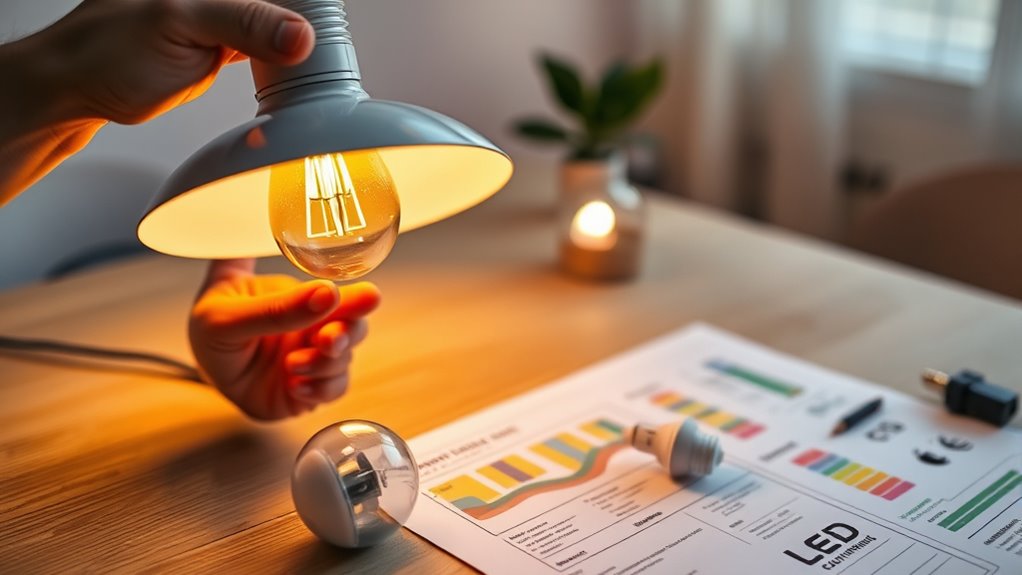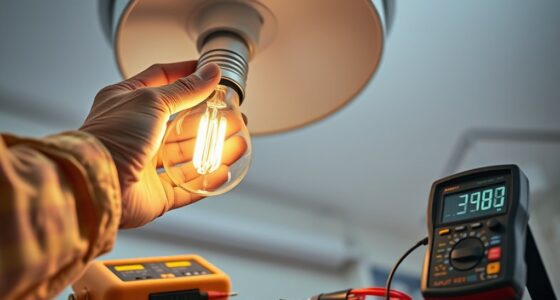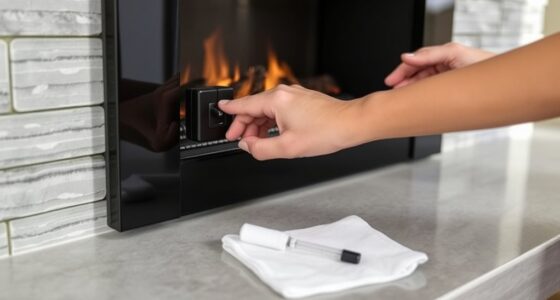When replacing bulbs and LEDs, start by analyzing your space’s lighting needs and choosing energy-efficient options like LEDs with high lumens and the right color temperature for your mood. Consider fixture compatibility, style, and dimming features to match your decor. Planning ahead helps you prioritize which areas need upgrades and guarantees proper installation for maximum results. Keep exploring to discover tips that bring both style and savings to your lighting updates.
Key Takeaways
- Assess current lighting fixtures and identify outdated or inefficient bulbs for replacement.
- Determine desired brightness, color temperature, and style to match your space’s decor and ambiance.
- Choose energy-efficient LEDs with appropriate lumens and wattage, considering long-term cost savings.
- Plan installation carefully, ensuring fixture compatibility and considering professional help if needed.
- Utilize lighting control systems to optimize energy use, adjust brightness, and enhance overall lighting experience.
Choosing the Right Bulbs and LEDs for Your Space

Replacing bulbs and LEDs can seem straightforward, but making informed choices can markedly impact your space’s functionality and style. The first step is understanding how energy efficiency and aesthetic design play essential roles in your decision-making process. Energy-efficient lighting not only reduces your electricity bills but also minimizes your carbon footprint, making it a smart long-term investment. Meanwhile, aesthetic design ensures your lighting complements your space’s overall look, creating an inviting atmosphere that reflects your personal style.
When selecting new bulbs or LEDs, focus on their energy consumption. Look for options with high lumens and low wattage, which indicates better energy efficiency. LED bulbs are particularly advantageous because they consume up to 75% less energy than traditional incandescent bulbs and last considerably longer. This means fewer replacements, less waste, and more savings over time. As you shop, pay attention to the bulbs’ color temperature, measured in Kelvins. Warm tones (around 2700K to 3000K) create cozy, inviting environments, perfect for living rooms and bedrooms. Cooler temperatures (4000K to 5000K) are better suited for workspaces or kitchens, where brighter, more alert lighting is beneficial.
Aesthetic design is equally essential. Bulbs and LEDs come in various shapes, sizes, and styles, so choose ones that enhance your decor. For instance, vintage-style Edison bulbs add a nostalgic charm to retro or industrial interiors, while sleek, minimalist designs suit modern spaces. Dimmable LEDs give you control over lighting intensity, allowing you to adjust the ambiance for different occasions, which adds both functionality and aesthetic appeal. Additionally, consider the fixture compatibility—ensure the bulbs you select fit your existing fixtures or plan for the necessary upgrades.
Furthermore, understanding lighting control systems can help you optimize your lighting setup for energy savings and convenience. Planning your replacement involves evaluating your current lighting setup and determining where improvements are most needed. Identify fixtures that are outdated or inefficient and prioritize replacing those first. Think about how each space is used and what mood you want to create; this will guide your choices in brightness and color temperature. Budget-wise, LEDs might seem pricier upfront but save you money in the long run through energy savings and durability. Keep in mind that proper installation is essential for best performance, so follow manufacturer instructions or consult a professional if needed. By balancing energy efficiency with aesthetic design, you’ll transform your lighting into a more functional, stylish, and cost-effective feature of your home.
Frequently Asked Questions
How Do I Dispose of Old Bulbs and LEDS Safely?
You should dispose of old bulbs and LEDs at designated recycling facilities to guarantee safe handling. Incandescent bulbs are not hazardous waste but still should go to recycling. Fluorescent bulbs contain mercury and are classified as hazardous waste, so don’t toss them in regular trash. Check local guidelines for disposal or recycling programs. Proper disposal prevents environmental harm and keeps hazardous materials out of landfills.
Can LED Bulbs Be Used With Dimmer Switches?
You flip the switch, and suddenly, your LED bulb flickers or hums—something’s not right. The secret lies in dimmer compatibility; not all LED bulbs work with standard dimmer switches. To avoid this, choose LED dimmer switches designed specifically for LEDs. These switches adjust brightness smoothly without flickering, transforming your space into a cozy haven. Always check the packaging for compatibility info before installing, and enjoy perfect lighting every time.
What Is the Lifespan Difference Between Bulbs and LEDS?
LEDs typically last 25,000 to 50,000 hours, considerably longer than traditional bulbs, which usually last about 1,000 hours. This lifespan difference makes LEDs much more energy-efficient and reduces replacement costs over time. While LEDs cost more upfront, their energy efficiency and durability save you money in the long run, making them a smarter choice for cost comparison and sustainability.
Are Smart Bulbs Compatible With All Lighting Fixtures?
Ever wondered if your smart bulbs will fit your fixtures? Most smart bulbs are compatible with standard fixtures like E26 or E27, but some may not suit specialty or enclosed fixtures. Checking your fixture’s compatibility guarantees smooth smart bulb integration. Are you aware of the specific socket type and size? Confirming fixture compatibility before buying guarantees your smart bulb will work seamlessly and enhance your lighting experience.
How Do I Determine the Brightness Needed for a Room?
To determine the brightness needed for a room, start with lumens calculation based on room size and purpose. For example, living rooms typically require 20 lumens per square foot, while kitchens need about 50 lumens. Refer to room lighting standards to match the lumens to each space. Measure your room, multiply its square footage by recommended lumens per square foot, and choose bulbs that meet or exceed that lumens output.
Conclusion
Think of your lighting choices as planting a garden—you need the right seeds to grow something beautiful. I once replaced my old bulbs with LEDs, and suddenly my living room felt brighter and more welcoming, like a sunrise after a long night. Just like tending a garden, choosing the perfect bulbs and LEDs transforms your space into a comfortable haven. With what you’ve learned, you’re now ready to light up your home confidently and brilliantly.









